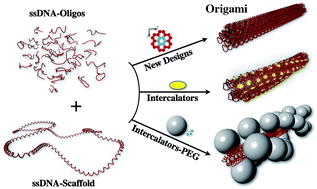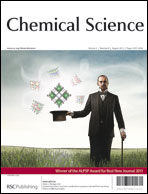Two design strategies for enhancement of multilayer–DNA-origami folding: underwinding for specific intercalator rescue and staple-break positioning†
Abstract
Single-layer DNA origami is an efficient method for programmable self-assembly of nanostructures approximating almost any desired two-dimensional shape from ∼5 MDa of DNA building material. In this method, a 7 kilobase single “scaffold” strand is assembled with hundreds of oligodeoxyribonucleotide “staple” strands to form a parallel array of double helices. Multiple layers of such DNA sheets also can be designed to assemble into a stack, enabling the construction of solid three-dimensional shapes with considerably greater mechanical rigidity than two-dimensional shapes; however, the folding yield often is much lower and the required folding times are much longer. Here we introduce two strategies for designing multi-layer DNA origami that demonstrate potential for boosting assembly yield: (1) individual base pairs can be inserted between crossovers, allowing for greater bowing of helices at positions away from crossovers and therefore reduced electrostatic repulsion. At the same time, this underwinding of double helices increases a destabilizing torsional strain energy but then also increases affinity for intercalators, and binding of such intercalators can relieve this stress. We also have exploited this enhanced affinity for intercalators to PEGylate the surface of the nanostructures in a noncovalent fashion using PEG-tris-acridine. (2) Positioning of staple-strand breaks in the DNA origami such that each staple strand includes a 14 nucleotide (nt) continuous segment that binds to a complementary 14 nt continuous segment of the scaffold can greatly improve folding yields.


 Please wait while we load your content...
Please wait while we load your content...